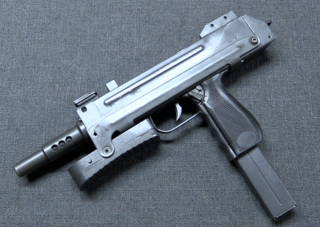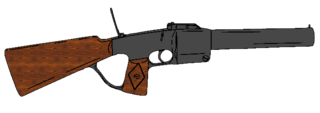A shotgun is a long-barreled firearm designed to shoot a straight-walled cartridge known as a shotshell, which discharges numerous small spherical projectiles called shot, or a single solid projectile called a slug. Shotguns are most commonly used as smoothbore firearms, meaning that their gun barrels have no rifling on the inner wall, but rifled barrels for shooting sabot slugs are also available.

Non-lethal weapons, also called nonlethal weapons, less-lethal weapons, less-than-lethal weapons, non-deadly weapons, compliance weapons, or pain-inducing weapons are weapons intended to be less likely to kill a living target than conventional weapons such as knives and firearms with live ammunition. It is often understood that unintended or incidental casualties are risked wherever force is applied, however non-lethal weapons minimise the risk of casualties as much as possible. Non-lethal weapons are used in policing and combat situations to limit the escalation of conflict where employment of lethal force is prohibited or undesirable, where rules of engagement require minimum casualties, or where policy restricts the use of conventional force. However, these weapons occasionally cause serious injuries or death due to allergic reactions, improper use and/or other factors; for this reason the term "less-lethal" has been preferred by some organizations as it describes the risks of death more accurately than the term "non-lethal", which some have argued is a misnomer.

A grenade launcher is a weapon that fires a specially designed, large-caliber projectile, often with an explosive, smoke, or gas warhead. Today, the term generally refers to a class of dedicated firearms firing unitary grenade cartridges. The most common type are man-portable, shoulder-fired weapons issued to individuals, although larger crew-served launchers are issued at higher levels of organization by military forces.

The M203 is a single-shot 40 mm under-barrel grenade launcher designed to attach to a rifle. It uses the same rounds as the older stand-alone M79 break-action grenade launcher, which utilizes the high-low propulsion system to keep recoil forces low. While compatible with many weapons, the M203 was originally designed and produced by the United States military for the M16 rifle and its carbine variant, the M4. The launcher can also be mounted onto a C7, a Canadian version of the M16 rifle; this requires the prior removal of the bottom handguard.

The M79 grenade launcher is a single-shot, shoulder-fired, break-action grenade launcher that fires a 40×46mm grenade, which uses what the US Army calls the High-Low Propulsion System to keep recoil forces low, and first appeared during the Vietnam War. Its distinctive report has earned it colorful nicknames, such as "Thumper", "Thump-Gun", "Bloop Tube", "Big Ed", "Elephant Gun", and "Blooper" among American soldiers as well as "Can Cannon" in reference to the grenade size; Australian units referred to it as the "Wombat Gun". The M79 can fire a wide variety of 40 mm rounds, including explosive, anti-personnel, smoke, buckshot, flechette, and illumination. While largely replaced by the M203, the M79 has remained in service in many units worldwide in niche roles.
A combat shotgun is a shotgun issued by militaries for warfare. The earliest shotguns specifically designed for combat were the trench guns or trench shotguns issued in World War I. While limited in range, the multiple projectiles typically used in a shotgun shell provide increased hit probability unmatched by other small arms.

The KS-23 is a Soviet shotgun. Because it uses a rifled barrel, it is officially designated by the Russian military as a carbine. KS stands for Karabin Spetsialniy, "Special Carbine". It is renowned for its large caliber, firing a 23 mm shotgun shell, equating to 6.278 gauge using the British and American standards of shotgun gauges and approximately 4 gauge using the current European standards, making it the largest-bore shotgun in modern use.

In current usage, a riot gun or less-lethal launcher is a type of firearm used to fire "non-lethal" or "less-lethal" ammunition for the purpose of suppressing riots or apprehending suspects with minimal harm or risk. Less-lethal launchers may be special purpose firearms designed for riot control use, or standard firearms, usually shotguns and grenade launchers, adapted for riot control use with appropriate ammunition. The ammunition is most commonly found in 12 gauge shotguns and 37mm or 40 mm grenade launchers.

The BXP is a 9×19mm submachine gun developed by Andries Piek, with the fully automatic version finalised in 1978, and the semi-automatic version for civilians coming later in 1984. Due to an international arms embargo against South Africa, South Africans designed and manufactured some weapons as a small firearms industry developed locally. The BXP was one of these locally designed and developed firearms, and is considered the final stage of development of the line of hand machine carbines that started with the LDP in Rhodesia and the Kommando in South Africa. Produced originally by the South African company Milkor (Pty) Ltd, its name 'BXP' stands for 'Blowback eXperimental Parabellum', hinting both at its operating mechanism as well as its caliber. The original automatic version of the BXP was intended for use by South African law enforcement, including the South African Police, the Correctional Services, and the specialised airport security unit based at the then Jan Smuts International Airport, Johannesburg.

The United States Armed Forces has created a plethora of different types of 40 mm grenades in both the low-velocity 40×46 mm and high-velocity 40×53 mm calibers which uses what it calls a high-low propulsion system which keeps recoil forces within the boundaries of an infantry weapon. Presented on this page is a basic overview.

The MAG-7 is a pump-action shotgun manufactured by Techno Arms PTY of South Africa since 1995.
37 mm flare or "1.5 inch" caliber is the specification for a common launching system for non-lethal and less-lethal ammunition. Such launchers are also often known as "gas guns" due to their original use by police for launching tear gas projectiles. 37 mm systems are typically smoothbore as rifling is unnecessary or even detrimental to the performance of the usual projectiles.
37 mm gun or 3.7 cm gun can refer to several weapons or weapons systems. The "37 mm" refers to the inside diameter of the barrel of the gun, and therefore the diameter of the projectile it fires. However, the overall size and power of the gun itself can vary greatly between different weapons, in spite of them all being called "37 mm" guns.

The HK69A1 is a 40 mm grenade launcher developed and produced by the German arms manufacturer Heckler & Koch (H&K). The weapon was designed to engage enemy troops and strongpoints out to a distance of 350 m; it can also be used to deploy smoke grenades and illumination flares.
The MEI Hellhound 40 mm low-velocity multi-purpose grenade is a fixed-type munition designed to be fired from a 40×46mm grenade launcher such as the M79, M203, M320, or Milkor MK-1. The round consists of a metal projectile body, a fuze, and a cartridge case assembly. Upon impact with the target, the firing pin is driven into the detonator, which in turn sets off the round, producing a jet which sets off the explosive from the base forward. This results in an armor-piercing jet of molten metal and fragmentation of the projectile body. The MEI Hellhound uses the same high-low propulsion system as other 40 mm grenade launchers.

Milkor (Pty) Ltd is a privately owned South African company established in 1980. The company is best known for the range of Milkor MGLs 40mm, used in more than 50 countries. Since 2017 Milkor has expanded their capabilities to include Land, Air and Sea and Cyber.

The Milkor MGL is a lightweight 40 mm six-shot revolver-type grenade launcher developed and manufactured in South Africa by Milkor (Pty) Ltd. The MGL was demonstrated as a concept to the South African Defence Force (SADF) in 1981. The MGL was then officially accepted into service with the SADF as the Y2. After its introduction in 1983, the MGL was gradually adopted by the armed forces and law enforcement organizations of over 50 countries. Total production since 1983 has been more than 50,000 units.

The Federal Riot Gun (FRG) is a firearm made by Federal Laboratories Inc., designed to fire non-lethal munitions. Its ammunition includes 37 and 38mm baton and tear gas rounds. The baton rounds were cylindrical, rubber projectiles.
The Milkor 40mm UBGL grenade launcher is a lightweight single-shot, underslung grenade launcher designed and developed in South Africa by Milkor (Pty) Ltd. It can be attached to most modern assault weapons and rifles using a Picatinny rail system. The UBGL is capable of firing standard 40mm rounds including illumination and observation rounds. Clip-on, clip-off mechanism allows the UBGL to be fitted, with an additional recoil buffer, to any weapon fitted with a Picatinny rail.













